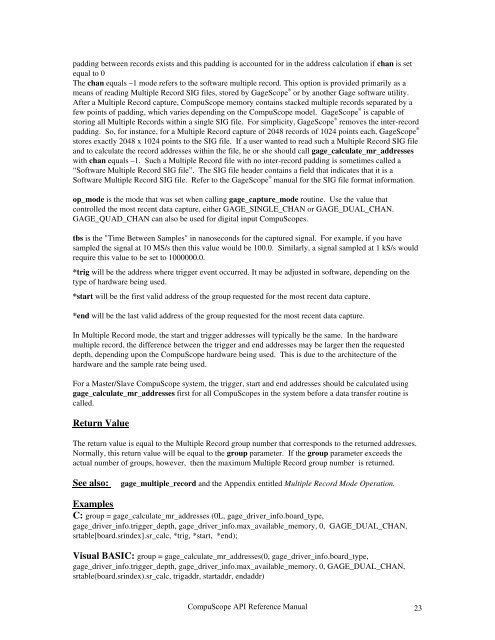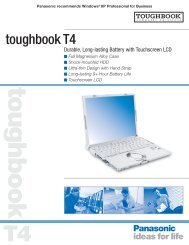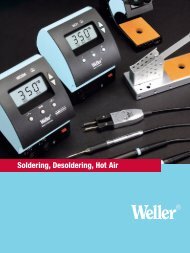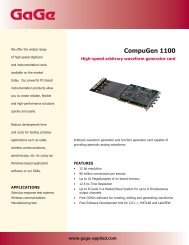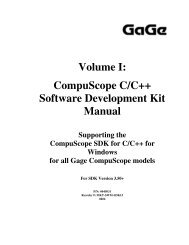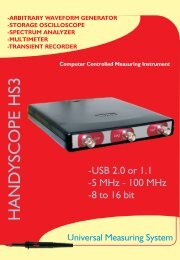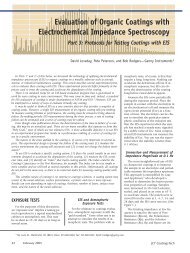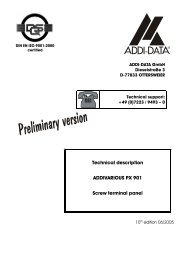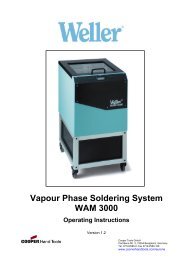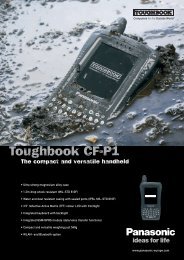CompuScope SDK Manua.. - Egmont Instruments
CompuScope SDK Manua.. - Egmont Instruments
CompuScope SDK Manua.. - Egmont Instruments
Create successful ePaper yourself
Turn your PDF publications into a flip-book with our unique Google optimized e-Paper software.
padding between records exists and this padding is accounted for in the address calculation if chan is set<br />
equal to 0<br />
The chan equals –1 mode refers to the software multiple record. This option is provided primarily as a<br />
means of reading Multiple Record SIG files, stored by GageScope ® or by another Gage software utility.<br />
After a Multiple Record capture, <strong>CompuScope</strong> memory contains stacked multiple records separated by a<br />
few points of padding, which varies depending on the <strong>CompuScope</strong> model. GageScope ® is capable of<br />
storing all Multiple Records within a single SIG file. For simplicity, GageScope ® removes the inter-record<br />
padding. So, for instance, for a Multiple Record capture of 2048 records of 1024 points each, GageScope ®<br />
stores exactly 2048 x 1024 points to the SIG file. If a user wanted to read such a Multiple Record SIG file<br />
and to calculate the record addresses within the file, he or she should call gage_calculate_mr_addresses<br />
with chan equals –1. Such a Multiple Record file with no inter-record padding is sometimes called a<br />
“Software Multiple Record SIG file”. The SIG file header contains a field that indicates that it is a<br />
Software Multiple Record SIG file. Refer to the GageScope ® manual for the SIG file format information.<br />
op_mode is the mode that was set when calling gage_capture_mode routine. Use the value that<br />
controlled the most recent data capture, either GAGE_SINGLE_CHAN or GAGE_DUAL_CHAN.<br />
GAGE_QUAD_CHAN can also be used for digital input <strong>CompuScope</strong>s.<br />
tbs is the "Time Between Samples" in nanoseconds for the captured signal. For example, if you have<br />
sampled the signal at 10 MS/s then this value would be 100.0. Similarly, a signal sampled at 1 kS/s would<br />
require this value to be set to 1000000.0.<br />
*trig will be the address where trigger event occurred. It may be adjusted in software, depending on the<br />
type of hardware being used.<br />
*start will be the first valid address of the group requested for the most recent data capture.<br />
*end will be the last valid address of the group requested for the most recent data capture.<br />
In Multiple Record mode, the start and trigger addresses will typically be the same. In the hardware<br />
multiple record, the difference between the trigger and end addresses may be larger then the requested<br />
depth, depending upon the <strong>CompuScope</strong> hardware being used. This is due to the architecture of the<br />
hardware and the sample rate being used.<br />
For a Master/Slave <strong>CompuScope</strong> system, the trigger, start and end addresses should be calculated using<br />
gage_calculate_mr_addresses first for all <strong>CompuScope</strong>s in the system before a data transfer routine is<br />
called.<br />
Return Value<br />
The return value is equal to the Multiple Record group number that corresponds to the returned addresses.<br />
Normally, this return value will be equal to the group parameter. If the group parameter exceeds the<br />
actual number of groups, however, then the maximum Multiple Record group number is returned.<br />
See also:<br />
gage_multiple_record and the Appendix entitled Multiple Record Mode Operation.<br />
Examples<br />
C: group = gage_calculate_mr_addresses (0L, gage_driver_info.board_type,<br />
gage_driver_info.trigger_depth, gage_driver_info.max_available_memory, 0, GAGE_DUAL_CHAN,<br />
srtable[board.srindex].sr_calc, *trig, *start, *end);<br />
Visual BASIC: group = gage_calculate_mr_addresses(0, gage_driver_info.board_type,<br />
gage_driver_info.trigger_depth, gage_driver_info.max_available_memory, 0, GAGE_DUAL_CHAN,<br />
srtable(board.srindex).sr_calc, trigaddr, startaddr, endaddr)<br />
<strong>CompuScope</strong> API Reference <strong>Manua</strong>l<br />
23


